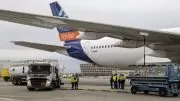By 2030, according to an EASA report dated 30 October 2025, the 2030 targets for SAF fuel production would be on track, although they will not replace all fossil fuels used in aviation at that time.
By 2050, according to a global study conducted by the International Air Transport Association (IATA), the world would theoretically be capable of producing nearly 400 million tonnes of sustainable aviation fuel (SAF). Although this represents a significant volume, it has been deemed insufficient to reach the aviation sector’s net-zero objective, which would require around 500 million tonnes of SAF per year.
At the end of 2025, global SAF production stands at around 2 million tonnes, representing barely 0.7% of worldwide kerosene consumption. It has been estimated that to meet the carbon-neutrality trajectory adopted by airlines, production would need to be multiplied by a factor of nearly 250 by 2050. The goal is therefore to reach approximately 500 million tonnes per year. Easier said than done.
SAF: What’s the Core Issue?
There are two main sources of SAF: biological SAF (bio-SAF), produced from biomass such as waste oils, solid waste biomass, ethanol–isobutanol, or sugars; and synthetic SAF (e-SAF), produced from CO₂ and hydrogen generated from renewable electricity (“green” hydrogen).
A key question is being asked across the aviation sector: do we really have enough resources—especially waste and residues—to support the large-scale ramp-up of SAF? The answer is, as often, nuanced. The resource base does exist. The global biomass potential is expected to reach around 10,000 million tonnes by 2030 and more than 12,000 million tonnes by 2050. The International Air Transport Association (IATA) identifies industrial capacity and the policy framework as the main barriers to SAF deployment. The organisation explains that these factors “may not keep pace.”
What the organisation emphasises is that the limiting factor is not primarily the availability of feedstock, but rather the sector’s ability to rapidly and massively deploy production technologies. Today, almost all industrial-scale SAF production units rely on the HEFA bio-SAF pathway (Hydroprocessed Esters and Fatty Acids), which processes used cooking oils and residual fats. More promising long-term pathways—gasification/Fischer-Tropsch, alcohol-to-jet, and synthetic e-SAF fuels made from green hydrogen—are advancing slowly, with most remaining at the demonstrator stage or still awaiting a final investment decision.
As a result, even assuming a significant ramp-up of SAF production, only about 70% of the theoretical bio-SAF potential would actually be converted into fuel by 2050, due to insufficient industrial capacity.
Europe at the Forefront… But Still a Tiny Market
On the European side, the European Union Aviation Safety Agency (EASA) published in autumn 2025 its first annual report on the implementation of the ReFuelEU Aviation regulation, providing a detailed snapshot of the year 2024 in terms of SAF.
Fuel suppliers reported having delivered 32.1 million tonnes of aviation fuel to EU airports in 2024, including 193,000 tonnes of SAF—barely 0.6% of the total volume consumed by the aviation sector. More specifically, the SAF used consisted of biofuels, mainly derived from used cooking oils (81%). The rest came primarily from animal fats. Not a single drop of e-SAF has yet appeared in the mix.
The market also remains extremely concentrated: 25 suppliers served only 33 EU airports across 12 Member States, and five countries (France, Germany, the Netherlands, Spain, and Sweden) alone accounted for 99% of the delivered volumes.
The EASA report nonetheless confirms that, based on identified projects, European SAF production could reach between 1.4 million tonnes and just over 5 million tonnes of bio-SAF, plus an additional 0.7 million tonnes of synthetic e-SAF, in the scenario projected for 2030. On paper, this would be enough to meet the EU requirement of incorporating 6% SAF into kerosene sold in the EU by 2030—provided that all projects reach maturity, which is far from guaranteed.
The Real Bottleneck: Industrial Capacity?
To bridge the 100-million-tonne gap by 2050, organizations emphasize the need for a comprehensive set of measures targeting both supply and demand. For aviation stakeholders, the message conveyed by industry bodies is clear: the battle for SAF in 2050 must be fought this decade—through investment decisions, public policies, and the sector’s ability to scale up industrial production quickly. On the one hand, yes, the world has the resources needed to build a SAF industry capable of producing several hundred million tonnes. On the other hand, no, this industry will not materialize spontaneously without a rapid scaling-up of technologies and a much more robust political framework.
For IATA, the financial dimension is—as often—the key lever to explore. According to the association, the transition to SAF must be supported through subsidies, guarantees, or even tax credits for airlines that get ahead of the 2050 objective, enabling the SAF production system to scale up and, in turn, drive costs down. Today, the lack of market size and industrialization in the sector results in costs that are roughly three times higher for a liter of SAF compared to a liter of conventional kerosene. The average price of SAF in 2024 was €2,085 per tonne (versus €734 per tonne for traditional kerosene). Hardly an incentive for airline executives to put SAF in their aircraft tanks without financial compensation.
These high costs reflect the current absence of a fully developed supply chain. A mature supply chain requires producers, distributors, and a commercial market—none of which exists today for these fuels. Significant investments are therefore needed in logistics infrastructure and biomass collection systems. For now, the numbers still don’t add up. And time, meanwhile, continues to tick away.
Jean-François Bourgain, November 16, 2025, for Aeromorning









Be the first to comment on "Sustainable Aviation Fuel (SAF): Falling Short of the Target"